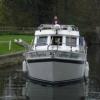Leaderboard
Popular Content
Showing content with the highest reputation on 16/08/14 in all areas
-
Cheers, just happened to be there and happy to help out, besides needed to get him out the way so i could get through the tunnel.3 points
-
Regular forum readers will know that I sometimes feel that some historic boat owners are aloof, unfriendly and generally nobbish to those not "in the clique". Today we passed Ilford being towed (I presume - didn't notice the name) by Aquarius on one of the Coventry's more twisty bits. Aquarius(?) (notably heavily ballasted at the front by the look of things) flashed up a sign saying "towing" as we hoved into view. A very long line later we passed Ilford and had barely time to start discussing the merits of long line vs cross strapping. Impressions? Flashing up the "towing" sign for 3 seconds gave me the information I needed, without any hint of patronisation. Vibes from Aquarius were friendly. Brief discussion (closing speed quite fast plus I probably failed to realise I could have started the conversation sooner due to local silence on board the butty) was again friendly. Vibe was just getting on with it, no aloofness or cliquiness or superiority. So what I am getting around to saying is full marks for the way they conducted themselves. Sorry if that sounds patronising and of course it might be considered to be a superfluous judgement, but it is made in the light of different impressions being created by some other historic boat owners/operators.1 point
-
Here is phrase you may be familiar with: Can you point me to a source that states you must be on the boat whilst moored? I must have missed that one.1 point
-
Sorry to hear about this, a real nightmare. A weeny bit of reassurance; a couple of years ago, Tim Tyler bought in a boat which had been dropped from slings so that the baseplate came down half across the dock edge and bent up. The floor inside came up about half a metre IIRC. He stripped the affected area and used hydraulic jacks to shove the plate back down, then Braidbar refitted that section. Boat was good as new afterwards (or better - it hadn't been a Braidbar fit out originally ). Best of luck with it, whatever happens!1 point
-
You are entitled to protest, but you asked the above question, and you got some advice. Some of the advice was to run away and not even consider a wooden boat, some of it was to look out for rot and be wary, some of it was to be aware of the maintenance required on a wooden boat, and some was that wooden boats are great. You didn't mention in your question that you need a 65ft plus boat, that's a bit different and quirky, and so on. I've had some experience of a wooden boat, and what looked cheap on paper became a money pit. Spending a little more up front on a GRP hull would have saved a lot of angst and money in the long term. With narrow boats, steel seems the usual alternative to wood. If you are considering a long wooden butty, with a view to adding an engine, on the basis that this is what your budget allows, rather than having a passion for wooden boats, and the work and expense involved, I think you should think long and hard. As I said in previous posts, you should do what suits you. I merely suggested that, if it was me, (and it's not me, it's you), I would be retreating in a manner that seems to offend you BTW Run away is a figure of speech .. I don't think anybody intends that you should actually be doing any running.1 point
-
Do you want to talk to everyone? I don't. Sometimes it's just a time issue. If I were an enforcement officer I wouldn't wish to be rude, but there are times I would cut people off unless I could help. Being as diplomatic as possible, but declining to get involved all the time. Doing whatever is humanly possible, but there has to be limits on available time to converse. I'm sure all reasonable communication is the order of the day.1 point
-
This post cannot be displayed because it is in a forum which requires at least 10 posts to view.
-
Up here, on that "awful" Ashton Canal, a wooden boat would be considered normal. There are currently 9(nine) living within a mile of where I type,only one of these is on the bottom, there are 5 motors and 4 butties/horseboats. The majority are used and move around the system quite frequently. None are lived on and condition varies from brand new rebuild to "awaiting serious rebuild" (the sunk one). As a wooden boat fan of many years, I would say you need to keep up with regular maintenance and sort any problems out ASAP, don't leave it.That's much like any other type of boat that I know of. Bill1 point
-
I'm not sure I understand the logic of what you're saying here, or at least what you think should happen. Would you contend that the EA (or other public body) should fulfill the role, much as the police or ambulance service respond to emergencies? Or perhaps that a separate charity should take it on, and provide hyper-local coverage, or perhaps an 'inland waterways rescue' service? Is it your opinion that there shouldn't be a rescue service on the river? Or are you just saying that the service has extended too far upstream, and should only cover as far as Teddington or Brentford or Putney? One argument against further segmenting the service is that multiple charities can be inefficient, and smaller organisations can struggle to raise and maintain funds in a competitive 'marketplace'. Charity mergers can improve overall efficiency. As for abandoning the service entirely, I can't quite accept that - plenty of people need rescuing in the Thames regularly. Who should be providing the service? (I also now realise that I have no idea what happens above Molesey lock - who comes to your rescue up there?!) Personally, as a raving socialist, I'd love to see these sorts of services (RNLI, air ambulances etc) freed from the pressure of fundraising through public donations, and instead fully funded through taxation, but I am well aware that I hold a minority stance on this1 point
-
1 point
-
This one keeps coming up and it takes a long time to get to the final answer because it depends on so many variables. I'll ask one of the mods to pin this so that we don't keep answering the same question. Will paralleling alternators reduce charge times? It depends upon:- 1. The size of the alternators in relation to the battery bank. 2. How far the batteries usually get discharged. 3. How fast the alternators are spun. 4. What other loads are being powered during charging. Answers. 1. and 2. If the alternators are very small (say less than about 15% of the battery bank size for each alternator) then paralleling them will almost certainly reduce charge times. There is a rule of thumb called amp.hour law charging (which is actually a play on what really goes on but it suffices for this purpose). This law states a battery will safely accept a charge current in amps equal to the number of amp.hours that need replacing. So a 400Ahr bank, at 50% SoC needs 200Ahrs replacing therefore it will accept a charge current of 200amps. After a short while that bank will have increased to 51% SoC, so now it will accept 196 amps. And so on. It can thus be seen that the idea of an alternator sized to 10% or 15% is complete crap. An alternator much bigger than this can be used and will result in massively reduced recharge times. If the batteries only ever get discharged to 90% SoC then at that state, the same 400Ahr bank will only safely accept 10% of 400 = 40 amps. So there is no point whatsoever in fitting an alternator bigger than this or in paralleling two 70 ampers. It would achieve nothing. But how many people only discharge to 90%? On a 400Ahr bank, with twin 70 amp alternators, parelleling them will almost certainly reduce recharge times. Anyone who says otherwise simply hasn't understood what is going on. 3. A huge problem on the inland waterways is alternators not being spun fast enough. Most marinisers (read engine painters) don't pulley the alternators up high enough. They have many excuses for not doing so, but whatever their excuse, it doesn't change the fact that they don't pulley them up properly. They might feel justified in leaving the alterntor spinning too slowly, they might be just saying things to justify their laziness in not being bothered to change the pulleys, but it doesn't change the reality. This isn't just my opinion, this is fact. Adverc reach exactly the same conclusion on their website. This means that the alternator does not produce anywhere near its full capability at tickover. If the engine is being run at tickover just to charge batteries then paralleling the alternators will almost certainly result in a massive increase in charge rate. On many off the shelf "canal boat" engines you typically double the charge curent at tickover by paralleling them. 4. A 70 amp alternator (even assuming it's pulley'd up properly) isn't going to put much charge into a battery if there is an inverter running at the same time pulling 71 amps from the batteries. In fact there will be a continual 1 amp discharge. In this case, paralleling up the other alternator will turn this into a charge. So you can see from the above that paralleling them can make a huge difference in many instances. Alternators don't "fight each other" if paralleled. During the bulk stage (ie when the extra current is needed) they both work at full hoot. When acceptance is reached (ie the regulation voltage of the alternators), one of them might shut down completely. This is no issue, it has only shut down because its charge current is no longer needed to maintain the battery voltage at acceptance. If its current was needed, it wouldn't have shut down in the first place because the voltage wouldn't have reached acceptance. If loads are put on that exceed the capability of the remaining alternator, then the other one will instantly fire back up again. Whether one alternator shuts down or not depends upon its regulator and in particular whether it is battery sensing (most external regs) or machine sensing (most internal regs). Machine sensing ones rarely shut down, battery sensing ones often do shut down. One issue that can rear its head is that the alternator shutting down can cause its charge warning light to come on and/or its tacho to stop working. This is a difficult (though not impossible) one to crack. With SmartGauge and SmartBank Advanced there is a feature built in to stop this happening. I see the external reg issue has come up again. With modern alternators they do nowt. Absolutely nothing. All they ever did was increase the charge voltage. That is it. The rest is marketing bullshit. Modern alternators already charge at the same voltage so adding one does nothing. Some mention the virtue of converting to battery sensing as this compensates for the losses in under sized battery cables and dodgy battery isolators. I maintain it is better to get rid of the losses that battery sensing tries to bodge its way round. This is achieved simply by replacing the battery cables with correctly sized cables and putting in proper battery isolators. When I used to actually wire boats up, as opposed to designing the equipment, I paralleled up literally hundreds of alternators, probably thousands. Every single one I did saw a reduced charge time of at least 20%, many as much as 30% and several by 50% or 60% Finally, don't think of it as paralleling the alternators. Think of it as paralleling the batteries. A subtle difference, but realise that, as a result of this subtle difference, if an alternator packs up, you will still get charge to both battery banks without lifting a finger. You can also emergency start the engine from the domestic bank via the split charge relay.1 point
This leaderboard is set to London/GMT+01:00








